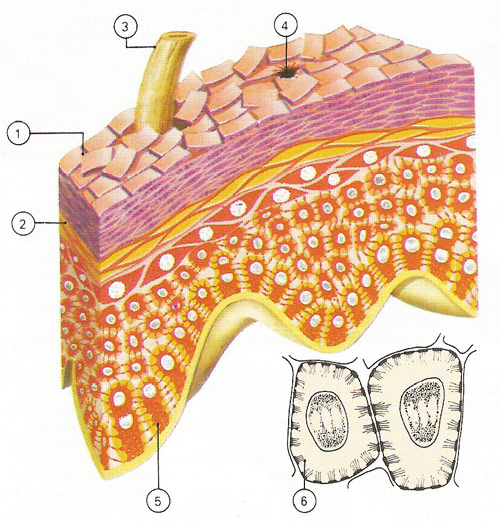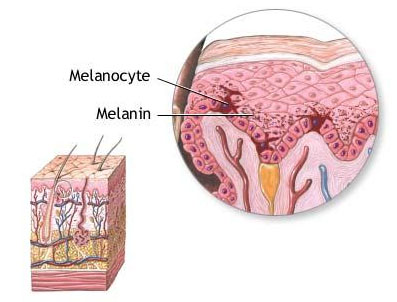epidermis

The epidermis or outer skin is covered with flattened (squamous) tile-like dead cells (1) filled with the protein keratin. It is keratin that toughens and waterproofs the skin. Millions of dead cells are shed (desquamated) from the surface all the time, to be replaced by new cells making their way up from below (2). Resistant to bacteria, the skin is penetrated only by hairs (3) and sweat pores (4). The epidermis and the deeper sin, or dermis (5), fit tightly together in a series of corrugations. Epidermal cells (6) cling to each other by means of special pronged attachments.

The epidermis is the outermost layer of cells covering an animal or plant. In vertebrates it is the thinner of two layers of skin, the other being the dermis. The epidermis may bear a variety of specialized structures, such as hair and feathers. The thickness of the human epidermis varies in different types of skin; it is only 0.05 millimeter thick on the eyelids, and is 1.5 millimeters thick on the palms and the soles of the feet. The epidermis contains the melanocytes, the Langerhans' cells (involved in the immune system in the skin), Merkel cells, and sensory nerves.
In invertebrates, the epidermis is normally only one cell thick and often secretes a non-cellular protective cuticle. Likewise in plants, there is an epidermis one cell-layer thick covered in aerial parts by a cuticle. Some plant epidermal cells are modified to form guard cells or hairs of various types.
Sublayers of the mammalian epidermis
The mammalian epidermis is made up of five sublayers that work together to continually rebuild the surface of the skin.
Basal cell layer
The basal layer, or Malpighian layer, is the innermost layer of the epidermis, and contains small round cells called basal cells. The basal cells continually divide, and new cells constantly push older ones up toward the surface of the skin, where they are eventually shed. The basal cell layer is also known as the stratum germinativum due to the fact that it is constantly germinating (producing) new cells.
The basal cell layer contains cells called melanocytes. Melanocytes produce the skin coloring or pigment known as melanin, which gives skin its tan or brown color and helps protect the deeper layers of the skin from the harmful effects of the sun. Sun exposure causes melanocytes to increase production of melanin in order to protect the skin from damaging ultraviolet rays, producing a suntan. Patches of melanin in the skin cause birthmarks, freckles, and age spots. Melanoma develops when melanocytes undergo malignant transformation.
Merkel cells, which are tactile cells of neuroectodermal origin, are also located in the basal layer of the epidermis.
Squamous cell layer
The squamous cell layer is located above the basal layer, and is also known as the stratum spinosum or "spiny layer" due to the fact that the cells are held together with spiny projections. Within this layer are the basal cells that have been pushed upward, however these maturing cells are now called squamous cells, or keratinocytes. Keratinocytes produce keratin, a tough, protective protein that makes up the majority of the structure of the skin, hair, and nails.
The squamous cell layer is the thickest layer of the epidermis, and is involved in the transfer of certain substances in and out of the body. The squamous cell layer also contains cells called Langerhans cells. These cells attach themselves to antigens that invade damaged skin and alert the immune system to their presence.
Stratum granulosum and the stratum lucidum
The keratinocytes from the squamous layer are then pushed up through two thin epidermal layers called the stratum granulosum and the stratum lucidum. As these cells move further towards the surface of the skin, they get bigger and flatter and adhere together, and then eventually become dehydrated and die. This process results in the cells fusing together into layers of tough, durable material, which continue to migrate up to the surface of the skin.
Stratum corneum
The stratum corneum is the outermost layer of the epidermis, and is made up of 10 to 30 thin layers of continually shedding, dead keratinocytes. The stratum corneum is also known as the "horny layer," because its cells are toughened like an animal's horn. As the outermost cells age and wear down, they are replaced by new layers of strong, long-wearing cells. The stratum corneum is sloughed off continually as new cells take its place, but this shedding process slows down with age. Complete cell turnover occurs every 28 to 30 days in young adults, while the same process takes 45 to 50 days in elderly adults.


